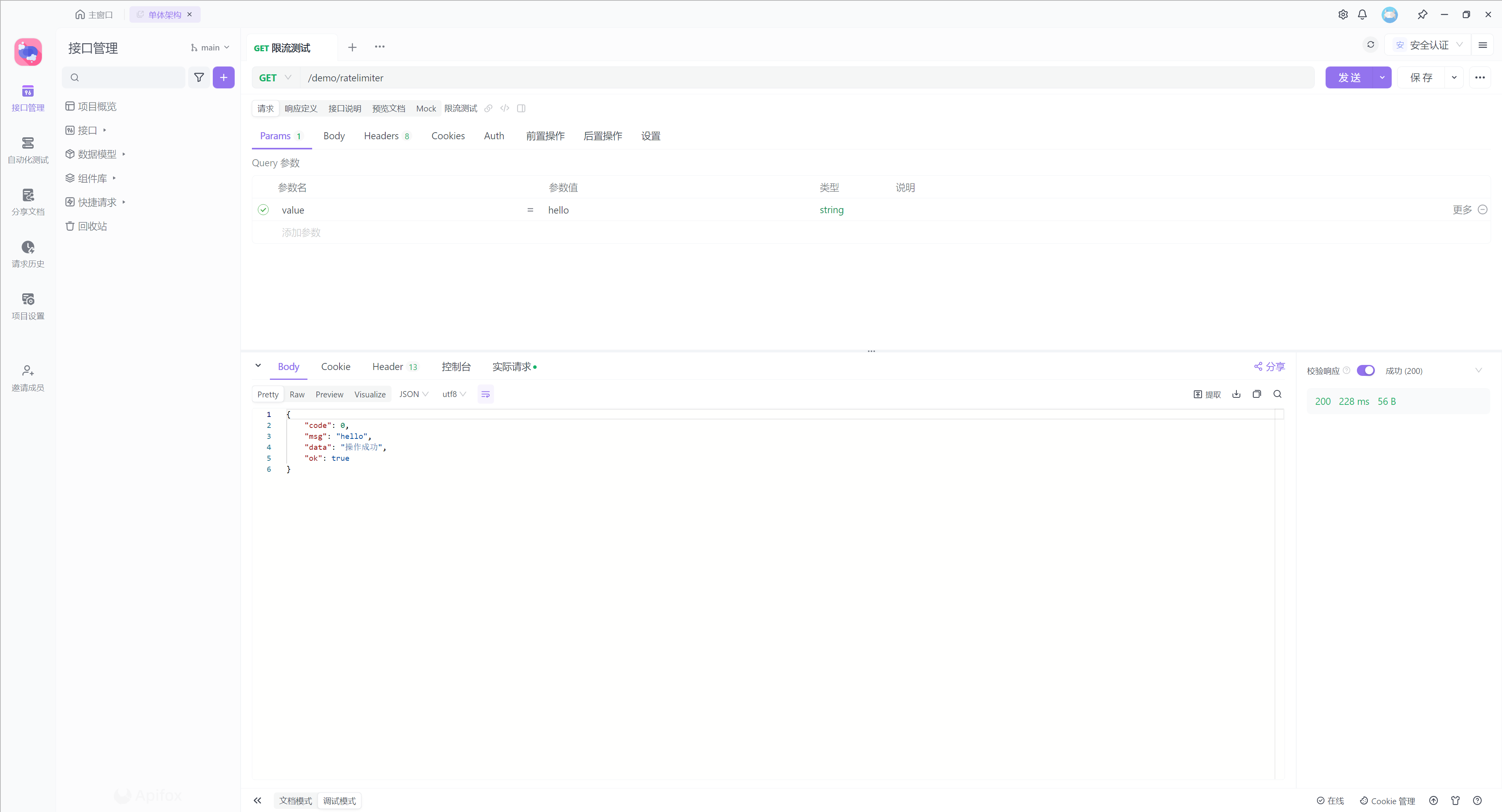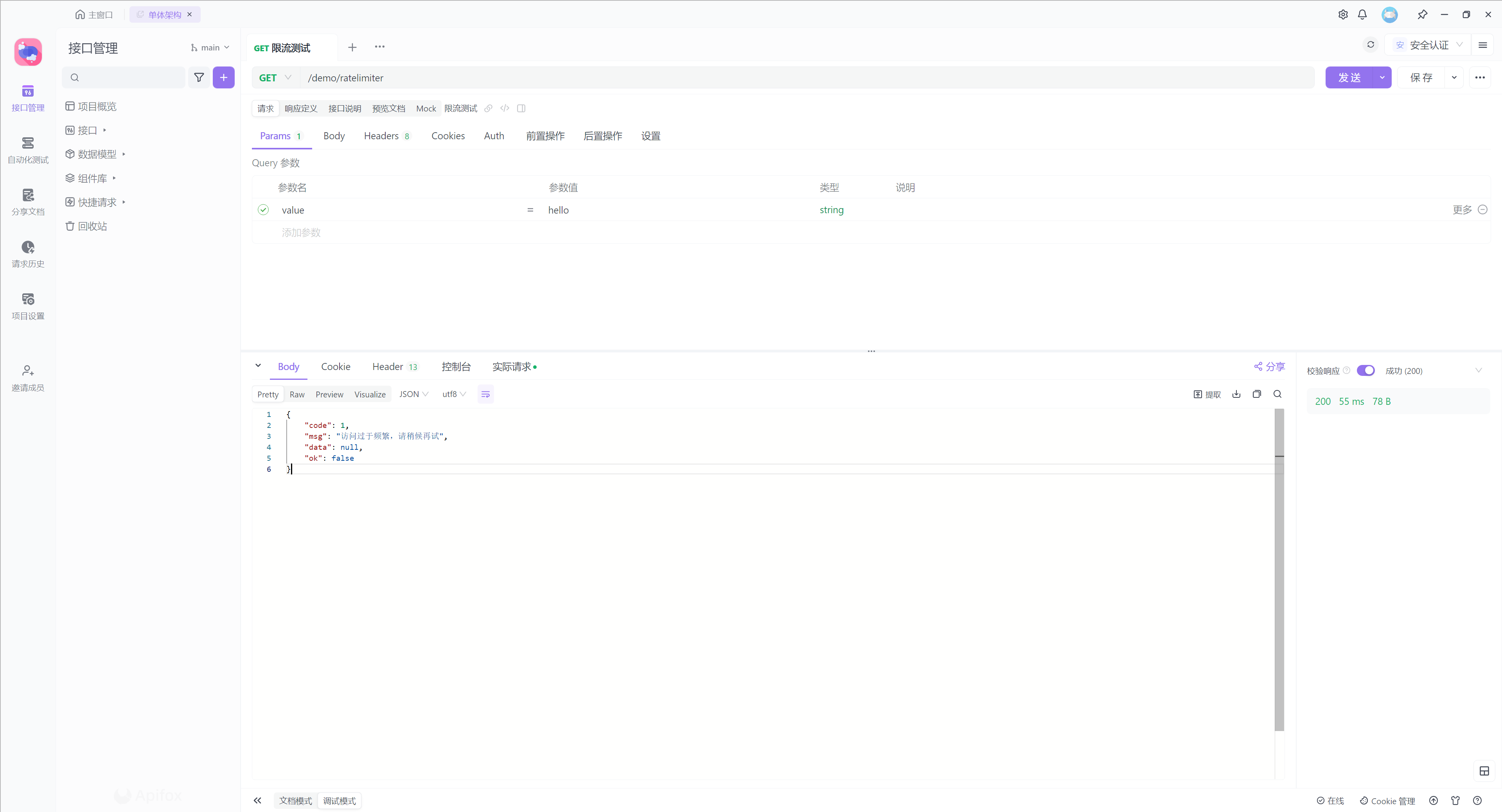Become a sponsor

限流(Rate Limiting)是一种保护系统免受过多请求冲击的技术手段。通过限制单位时间内的请求数量,可以防止系统过载、避免资源耗尽,并确保服务的稳定性。
项目中集成限流功能的主要场景包括:
防止恶意请求:限制单个用户或 IP 的请求频率。
保护核心接口:确保核心业务接口不会被过多请求拖垮。
流量控制:在高峰期平滑流量,避免系统崩溃。在项目中使用 AOP(面向切面编程)注解实现防重复提交具有以下优势:
1. 代码解耦:将日志记录逻辑与业务逻辑分离,避免代码重复,提升代码可读性和可维护性。
2. 灵活性与扩展性:通过注解可以灵活地控制哪些方法需要记录日志,便于扩展和修改日志记录逻辑。
3. 非侵入性:无需修改现有业务代码,只需在方法上添加注解即可实现日志记录。
4. 集中管理:日志记录逻辑集中在切面中,便于统一管理和维护。
5. 提高开发效率:通过注解方式快速实现日志功能,减少重复代码编写。在 xiaomayi-common/xiaomayi-ratelimiter 模块中定义的防重复提交的 AOP 切面 RateLimiter 文件,内容如下:
package com.xiaomayi.ratelimiter.annotation;
import com.xiaomayi.ratelimiter.enums.LimiterType;
import java.lang.annotation.*;
/**
* <p>
* 限流注解
* </p>
*
* @author 小蚂蚁云团队
* @since 2023-06-16
*/
@Target({ElementType.TYPE, ElementType.METHOD})
@Retention(RetentionPolicy.RUNTIME)
@Documented
@Inherited
public @interface RateLimiter {
/**
* 限流KEY,支持Spring的el表达式动态获取方法参数
* 使用案例:#code.id #{#code}
*
* @return 返回结果
*/
String key() default "";
/**
* 限流时间,单位:秒
*
* @return 返回结果
*/
int time() default 60;
/**
* 限流次数
*
* @return 返回结果
*/
int count() default 100;
/**
* 限流类型
*
* @return 返回结果
*/
LimiterType type() default LimiterType.DEFAULT;
/**
* 限流提示语,支持国际化,格式案例:{code}
*
* @return 返回结果
*/
String message() default "{rate.limiter.message}";
}package com.xiaomayi.ratelimiter.aspect;
import cn.hutool.extra.spring.SpringUtil;
import com.xiaomayi.core.constant.CacheConstant;
import com.xiaomayi.core.exception.BizException;
import com.xiaomayi.core.utils.MessageUtils;
import com.xiaomayi.core.utils.ServletUtils;
import com.xiaomayi.core.utils.StringUtils;
import com.xiaomayi.ratelimiter.annotation.RateLimiter;
import com.xiaomayi.ratelimiter.enums.LimiterType;
import com.xiaomayi.redis.utils.RedisUtils;
import lombok.extern.slf4j.Slf4j;
import org.aspectj.lang.JoinPoint;
import org.aspectj.lang.annotation.Aspect;
import org.aspectj.lang.annotation.Before;
import org.aspectj.lang.reflect.MethodSignature;
import org.redisson.api.RateType;
import org.springframework.context.expression.BeanFactoryResolver;
import org.springframework.context.expression.MethodBasedEvaluationContext;
import org.springframework.core.DefaultParameterNameDiscoverer;
import org.springframework.core.ParameterNameDiscoverer;
import org.springframework.expression.Expression;
import org.springframework.expression.ExpressionParser;
import org.springframework.expression.ParserContext;
import org.springframework.expression.common.TemplateParserContext;
import org.springframework.expression.spel.standard.SpelExpressionParser;
import java.lang.reflect.Method;
/**
* <p>
* 限流AOP切面
* </p>
*
* @author 小蚂蚁云团队
* @since 2023-06-16
*/
@Slf4j
@Aspect
public class RateLimiterAspect {
/**
* 定义表达式解析器
*/
private final ExpressionParser parser = new SpelExpressionParser();
/**
* 定义解析模版
*/
private final ParserContext parserContext = new TemplateParserContext();
/**
* 方法参数解析器
*/
private final ParameterNameDiscoverer pnd = new DefaultParameterNameDiscoverer();
/**
* 切点之前调用
*
* @param point 切点
* @param rateLimiter 限流注解
*/
@Before("@annotation(rateLimiter)")
public void doBefore(JoinPoint point, RateLimiter rateLimiter) {
int time = rateLimiter.time();
int count = rateLimiter.count();
try {
String combineKey = getCombineKey(rateLimiter, point);
RateType rateType = RateType.OVERALL;
if (rateLimiter.type() == LimiterType.CLUSTER) {
rateType = RateType.PER_CLIENT;
}
long number = RedisUtils.rateLimiter(combineKey, rateType, count, time);
if (number == -1) {
String message = rateLimiter.message();
if (StringUtils.startsWith(message, "{") && StringUtils.endsWith(message, "}")) {
message = MessageUtils.message(StringUtils.substring(message, 1, message.length() - 1));
}
throw new BizException(message);
}
log.info("限制令牌 => {}, 剩余令牌 => {}, 缓存key => '{}'", count, number, combineKey);
} catch (Exception e) {
if (e instanceof BizException) {
throw e;
} else {
throw new RuntimeException("服务器限流异常,请稍候再试", e);
}
}
}
/**
* 获取组合KEY
*
* @param rateLimiter 限流注解
* @param point AOP切点
* @return 返回结果
*/
private String getCombineKey(RateLimiter rateLimiter, JoinPoint point) {
String key = rateLimiter.key();
if (StringUtils.isNotBlank(key)) {
MethodSignature signature = (MethodSignature) point.getSignature();
Method targetMethod = signature.getMethod();
Object[] args = point.getArgs();
//noinspection DataFlowIssue
MethodBasedEvaluationContext context =
new MethodBasedEvaluationContext(null, targetMethod, args, pnd);
context.setBeanResolver(new BeanFactoryResolver(SpringUtil.getBeanFactory()));
Expression expression;
if (StringUtils.startsWith(key, parserContext.getExpressionPrefix())
&& StringUtils.endsWith(key, parserContext.getExpressionSuffix())) {
expression = parser.parseExpression(key, parserContext);
} else {
expression = parser.parseExpression(key);
}
key = expression.getValue(context, String.class);
}
StringBuilder stringBuffer = new StringBuilder(CacheConstant.RATE_LIMIT_KEY);
stringBuffer.append(ServletUtils.getRequest().getRequestURI()).append(":");
if (rateLimiter.type() == LimiterType.IP) {
// 获取客户端请求IP
stringBuffer.append(ServletUtils.getClientIP()).append(":");
} else if (rateLimiter.type() == LimiterType.CLUSTER) {
// 获取客户端实例id
stringBuffer.append(RedisUtils.getClient().getId()).append(":");
}
return stringBuffer.append(key).toString();
}
}在 pom.xml 配置文件中引入以下依赖:
<!-- 限流模块 -->
<dependency>
<groupId>com.xiaomayi</groupId>
<artifactId>xiaomayi-ratelimiter</artifactId>
</dependency>在需要设置限流的方法上添加以下注解:
@RateLimiter(count = 2, time = 10)使用案例:
package com.xiaomayi.admin.controller.demo;
import com.baomidou.mybatisplus.core.conditions.query.LambdaQueryWrapper;
import com.xiaomayi.admin.entity.DataModel;
import com.xiaomayi.core.utils.R;
import com.xiaomayi.ratelimiter.annotation.RateLimiter;
import com.xiaomayi.system.entity.DictItem;
import com.xiaomayi.system.entity.User;
import com.xiaomayi.system.service.UserService;
import com.xiaomayi.system.utils.DictResolver;
import lombok.AllArgsConstructor;
import lombok.extern.slf4j.Slf4j;
import org.springframework.web.bind.annotation.*;
import java.util.ArrayList;
import java.util.List;
/**
* <p>
* 测试案例 前端控制器
* 特别备注:此文件非项目本身有效文件,仅仅是工程师编写测试案例使用,留个备份未删除
* 实际项目使用时请删除此文件,以免造成其他影响
* </p>
*
* @author 小蚂蚁云团队
* @since 2024-05-21
*/
@Slf4j
@RestController
@RequestMapping("/demo")
@AllArgsConstructor
public class DemoController {
private final UserService userService;
/**
* 全局限流
*
* @param value 参数值
* @return 返回结果
*/
@RateLimiter(count = 2, time = 10)
@GetMapping("/ratelimiter")
public R test(String value) {
return R.ok("操作成功", value);
}
}请求网络请求时会自动放行并返回结果:
{
"code": 0,
"msg": "hello",
"data": "操作成功",
"ok": true
}使用 ApiFox 调试工具测试结果如下图:

网络请求频次超过设置的限流注解参数时,会自动触发限流机制,并返回限流响应结果:
{
"code": 1,
"msg": "访问过于频繁,请稍候再试",
"data": null,
"ok": false
}使用 ApiFox 调试工具测试结果如下图:

根据项目需求选择合适的限流方案,可以有效保护系统免受过多请求的冲击,提升系统的稳定性和可靠性。